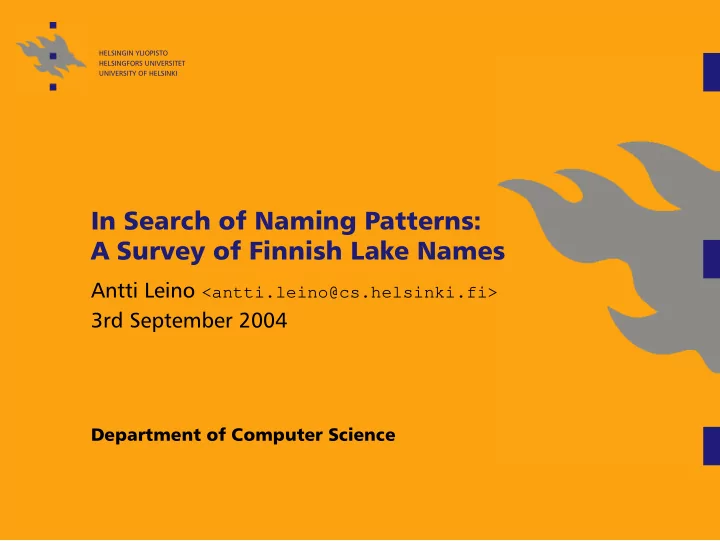

HELSINGIN YLIOPISTO HELSINGFORS UNIVERSITET UNIVERSITY OF HELSINKI In Search of Naming Patterns: A Survey of Finnish Lake Names Antti Leino <antti.leino@cs.helsinki.fi> 3rd September 2004 Department of Computer Science
Introduction Patterns and analogy play often an important role in naming This happens even when there are other motivations for the name How to prove this? Attempt to �nd groups of names that often appear near each other If such groups are found, see if the constituent names are instances of the same pattern
Data Place Name Register Used by the National Land Survey of Finland to produce the 1:20 000 Basic Map Lake names Occurrences Names Named places All toponyms ≥ 1 303 626 717 747 Lakes ≥ 1 25 178 58 267 This study ≥ 20 331 19 230
Number of similarly-named lakes Linear scale Logarithmic scale
Methods Spatial Statistics Speci�cally, small-scale interactions between name occurrences K function: measure of spatial interactions Data Mining Branch of Computer Science Attempts to �nd interesting new information in large corpora of data Tools to �nd groups of names whose mutual K functions are interesting
K function A measure of the attraction / repulsion of point objects Rough meaning: if the points were randomly distributed, one would need an area of K ( r ) to �nd as many points that really are within radius r of the actual points For spatially random data, K ( r ) = π r 2 Spatial attraction: K ( r ) > π r 2 Spatial repulsion: K ( r ) < π r 2 In this study: a variant for two sets of points, each with a spatially non-uniform distribution
Results There are groups of names that cluster around each other on a scale of even 1 km or less Some of these result from cultural phenomena or natural features At least two main types of naming patterns Inductive names Contrastive names Both these main types appear to be very productive
Cultural and natural connections Cultural connections Niittylampi 'Meadow Pond' � Vasikkalampi 'Calf Pond' Myllyjärvi 'Mill Lake' � Kirkkojärvi 'Church Lake' Natural connections Paskolampi 'Shit Pond' � Liejulampi 'Mud Pond' Kaitajärvi 'Narrow Lake' � Hoikkajärvi 'Thin Lake' Not very easy to spot (but then, these are not patterns)
Inductive and Contrastive names Inductive Mäntyjärvi 'Pine Lake' � Mäntylampi 'Pine Pond' Iso Haukilampi 'Great Pike Pond' � Pieni Haukilampi 'Small Pike Pond' Some overlap with the next category Contrastive Mustalampi 'Black Pond' � Valkealampi 'White Pond' Valkeajärvi 'White Lake' � Mustalampi 'Black Pond' Valkeinen 'The White' � Mustalampi 'Black Pond' Ahvenlampi 'Perch Pond' � Haukilampi 'Pike Pond'
Structure of lake names Leaving here the traditional terms of naming pattern and analogy ; instead, changing point of view to that of Construction Grammar 1 Name consists of a head denoting the type of place, preceded by a modi�er Syn cat NPr Syn fcn mod Syn cat N Sem locality 1 Although a separate school, this is functionally equivalent and ideologically mostly compatible with Cognitive Grammar
Main toponymic construction Three main subtypes, depending on the modi�er Adjective (eg. Mustalampi 'Black Pond' ) Noun in the genetive case (eg. Kaakkurinlampi 'Loon's pond' ; rare in names) Noun in the nominative case (eg. Housulampi 'Trouser Pond' ; often no appellative homonym) Even names that have a corresponding common noun construction occur often in pairs ⇒ likely did not originate entirely as descriptive designations
Variation in naming Existing name used to give a construction later used for creating a new name Beware: somewhat heretical in CG terms Syn cat NPr Syn fcn mod Syn cat N (1.2’) cat N Sem locality Sem fish lampi Syn cat NPr Syn cat NPr Ahvenlampi Haukilampi Syn fcn mod Syn cat N Syn fcn mod Syn cat N (1.2.1) (1.2.2) cat N Sem locality cat N Sem locality Sem Perch Sem Pike ahven lampi hauki lampi
Inductive naming The existing toponym is relevant (cf. Ahvenkorpi 'Perch Waste' near Ahvenjärvi 'Perch Lake') Easiest to include it in the construction Syn cat NPr (2) Syn fcn mod Syn cat NPr Syn cat NPr Syn fcn mod Syn cat NPr Syn cat NPr (2.1) cat A Sem size Syn cat NPr Syn cat NPr Syn fcn mod Syn cat NPr Syn fcn mod Syn cat NPr (2.2) cat A cat A Sem size Sem size
Conclusions Clearly, the old hypothesis was right: analogy plays an important role in naming lakes Naming pattern as a term does not feel right Sounds like something that can be clearly de�ned Most of the �patterns� are rather small and have an ad-hoc nature Not necessarily just the term that needs �xing, but possibly the concept as well Construction Grammar / Cognitive Grammar seems a promising approach However, further work is needed on the theoretical side
Recommend
More recommend